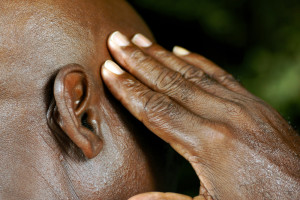 A cluster headache is a very specific, excruciating, stabbing/sharp head and face pain, usually located around or behind one eye. It is usually associated with tearing, clear nasal discharge or stuffiness, and forehead sweating on the affected side. These headaches are usually short, occur in the morning, and affect men more often than women. They are usually associated with marked agitation, and may be triggered by alcohol consumption. It is likely nerve and blood vessel abnormalities produce this headache. Pharmaceuticals to stop (oxygen, anti-migraine, opiates) and prevent (calcium channel blockers, anti-depression and anti-seizure classes) cluster headaches are commonly used; surgery to destroy the affected nerve and deep brain stimulation are effective treatments for severe cases. [1]
A cluster headache is a very specific, excruciating, stabbing/sharp head and face pain, usually located around or behind one eye. It is usually associated with tearing, clear nasal discharge or stuffiness, and forehead sweating on the affected side. These headaches are usually short, occur in the morning, and affect men more often than women. They are usually associated with marked agitation, and may be triggered by alcohol consumption. It is likely nerve and blood vessel abnormalities produce this headache. Pharmaceuticals to stop (oxygen, anti-migraine, opiates) and prevent (calcium channel blockers, anti-depression and anti-seizure classes) cluster headaches are commonly used; surgery to destroy the affected nerve and deep brain stimulation are effective treatments for severe cases. [1]
In Chinese medical terms, this is a condition of “Liver Yang or Fire Rising”, possibly with “Liver Blood Stagnation”/”Heat in the Blood Division”. Body acupuncture would be difficult in the moment, as agitation is severe, and most sufferers wish to pace. However, ear acupuncture and Neurological Scalp Acupuncture may abort an acute cluster headache. For prevention between episodes, body acupuncture and Chinese Herbal Medicine are most beneficial for this condition, along with alcohol avoidance. [2] [3] [4]
Learn more about Cluster Headache
X
These brief overviews of conditions represent distillations of basic and current medical reviews from the following sources:
[1] Conventional Medical Sources
“Harrison’s Principles of Internal Medicine: Volumes 1 and 2, 18th Edition”. Dan Longo Anthony Fauci, Dennis Kasper, Stephen Hauser, J. Jameson, Joseph Loscalzo. McGraw-Hill Professional; (July, 2011)
Medscape eMedicine Physician’s online resource. Various review articles accessed June 2013:
Migraine Headache
Jasvinder Chawla, MD, MBA Chief of Neurology, Hines Veterans Affairs Hospital; Associate Professor of Neurology, Loyola University Medical Center
Tension Headache, Cluster Headache
Michelle Blanda, MD Chair, Department of Emergency Medicine, Summa Health System Akron City/St Thomas Hospital; Professor of Emergency Medicine, Northeastern Ohio Universities College of Medicine
Temopromandibular Joint Disorders
Charles F Guardia III, MD Instructor in Neurology, Department of Neurology, Dartmouth Hitchcock Medical Center, Geisel School of Medicine at Dartmouth
Trigeminal Neuralgia
Manish K Singh, MD Assistant Professor, Department of Neurology, Teaching Faculty for Pain Management and Neurology Residency Program, Hahnemann University Hospital, Drexel College of Medicine; Medical Director, Neurology and Pain Management, Jersey Institute of Neuroscience
[2], [3] “Acupuncture Energetics: A Clinical Approach for Physicians”. Joseph M. Helms. Medical Acupuncture Publishers; 1st Edition. (1995)
- “Foundations of Chinese Medicine: A Comprehensive Text for Acupuncturists and Herbalists”. Giovanni Maciocia. Churchill Livingstone; 2 Edition (July, 2005).
- “Diagnosis in Chinese Medicine: A Comprehensive Guide”. Giovanni Maciocia. Churchill Livingstone; 1st Edition (January, 2004).
[4] “Chinese Scalp Acupuncture”. Jason Ji-shun Hao, Linda Ling-zhi Hao and Honora Lee Wolfe. Blue Poppy Press; 1st Edition. (November, 2011)
